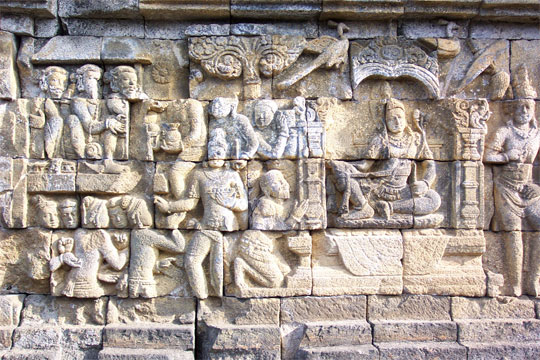The Karangtengah inscription mentions a jinalaya (the realm of those who have conquered worldly desire and reached enlightenment) that was inaugurated by Pramodhawardhani, the daughter of King Samaratungga in 9th century. Another inscription, the Tri Tepusan inscription, mentions a sacred building honoring the ancestors named Bhumishambara or in some other source, Bhumishambara Budhara, which according to a historian de Casparis, means "the mountain of combined virtues of the ten stages of Boddhisattvahood". So this suggests that Borobudur was originally known as Bhumishambara.
 |
| The many stupas in Borobudur temple, each with a Buddha statue inside. |
More on Pramodhawardhani:
Pramodhawardhani (also known as Çrī Kahulunnan or Çrī Sanjiwana. In Indonesian known as Pramodyawardhani) was the queen consort of king Rakai Pikatan of Medang Kingdom in 9th century Central Java. She was the daughter of Sailendran king Samaratungga. Her royal marriage to Pikatan, the prince of Sanjaya dynasty, was believed to be a political reconciliation between Buddhist Sailendra with Hindu Sanjaya dynasties. This would consolidate the Sailendra dynasty's expansive territory that spanned across Indonesia all the way to Cambodia.
Pramodhawardhani - Pikatan's notable achievements were: defeating and expelling Balaputradewa to Srivijaya (Sumatra), as well as constructing Prambanan and Plaosan temples.
Pramodhawardhani is often thought to be portrayed in avatar form as prajnaparamita, which in Mahayana Buddhism, is the perfection of transcendental wisdom.
 |
| Pramodhawardhani/Prajnaparamita |
Sailendra Dynasty
Śailēndra (Sanskrit: शैलेन्द्र Lord of the Mountain) or Śailēndravaṃśa ("Śailēndra dynasty") was the name of an influential Indonesian dynasty that emerged in 8th century Java.
The Śailēndras were active promoters of Mahayana Buddhism and covered the Kedu Plain of Central Java with Buddhist monuments.
The Śailēndras are considered to be a thalassocracy and ruled maritime Southeast Asia, however they also relied on agriculture pursuits through intensive rice cultivation on Central Java. The dynasty appeared to be the ruling family of both the Medang Kingdom of Central Java for some period and Srivijaya in Sumatra.
Some of the reliefs in Borobudur, depicting Sailendran king and queen, in a Maharajalilasana (King's posture or royal ease [ha, they even have a thing like this, fascinating!]) pose among their servants and/or subjects.
There is also "The Prajnaparamita of Java", referring to a famous depiction of Boddhisattvadevi Prajñāpāramitā, originated from 13th century Singhasari, East Java, Indonesia. The statue is of great aesthetical and historical value, and is considered as the masterpiece of classical Hindu-Buddhist art of ancient Java.
The statue of Prajnaparamita of East Java is probably the most famous depiction of the goddess of transcendental wisdom. The serene expression and meditative pose and gesture suggest peace and wisdom, in contrast with rich and intricate jewelry and decorations. The goddess is in a perfect lotus meditative position called vajrasana posture, sitting on a double lotus cushion called padmasana (lotus pedestal) on top of a square base. The statue sits before a carved stela.
The goddess performs dharmachakra-mudra (the mudra symbolizing turning the wheel of dharma).
Her left arm is placed around an utpala (blue lotus), on top of which sits her attribute; the lontar palmleaf book Prajnaparamita Sutra. The head and face is perfectly chiseled, with downcast eyes and forehead urna (a spiral or circular dot placed on the forehead of Buddhist images as an auspicious mark). The goddess wears her hair high arranged in Jatamakuta crown, and behind her head radiates prabhamandala (a halo or aura of light to suggest a divinity that has reached the highest wisdom).
Beautiful history 💓
Thanks to the all-knowing wiki and the great world wide web for this note!




No comments:
Post a Comment